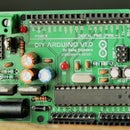Introduction: Rechargeable Digital Voltmeter Using ICL7107 ADC
In this tutorial I will show you how to make a super simple digital voltmeter that can measure voltages from 20 mV to 200V. This project will not use any microcontroller like arduino. In place of that a ADC, i.e. ICL7107 will be used with some passive components. It will be powered by a Li-ion battery which can run this voltmeter for 12 hours. Once it's run out of juice, you can charge it by using a micro-usb cable.
You can watch the following video which covers the same topic with detailed discussion.
Do subscribe to our channel if you like this project. So without further ado let's start the video.
Step 1: Gather the Required Components
You will need the following items to make this voltmeter ( No quantity mentioned means 1) -
- ICL7107 IC, 40 pin IC base
- TL7660 IC, 8 pin IC base
- 4 X 7 Segment display common anode
- 10k Potentiometer
- Terminal block
- Female banana headers
- Male and female headers
- 2 X 10uF caps
- 5 X 330E Resistor
- 2 X 100k, 2 X 10k, 1 X 1k Resistor
- 1 X 1M, 1 X 22k, 1 X 47k Resistor
- 0.22uF, 0.47uF caps
- 2 X 100nF, 1 X 100pF caps
- Slide switch for ON/OFF
- Multimeter probes
- Li-ion battery
- Li-ion charger based on TP4056
- 3.7-4.2v to 5v booster
Gather all these components and then move on to design the circuit.
BOM - https://bit.ly/2S97XHg
Step 2: Draw the Circuit Diagram
I used EasyEDA to draw this whole circuit. EasyEDA is a great portal to design big and complex circuits. It makes life a lot easier afterwards. You can find the circuit diagram in the following PDF for your reference.
Circuit Diagram - https://tinyurl.com/y8esya6u
Step 3: Make the Power Supply Module
So in the power supply module there are basically 3 components. A Li-ion battery, one TP4056 Li-po charger and a voltage booster that will step up the voltage coming from the battery to 5V. I have used a 1000maH Li-ion here, but you can go with a smaller capacity battery. The connections are be seen in the following PDF.
Power supply circuit diagram - https://tinyurl.com/y8xdxmk2
Step 4: Design the PCB and Order
Once the circuit is drawn, it's time to design the PCB. I used the PCB design portal in the EasyEDA for designing my PCB. For beginners this is more appropriate than Eagle or any other CAD software. Once the PCB is designed, I uploaded the gerber file to JLCPCB and dialed in the required settings. Then I ordered 10 of these PCBs from them. JLCPCB is one of the best PCB manufacturer of recent times and the pricing is also pretty reasonable. I will recommend to use their service to everyone if you are thinking about prototyping your project. So after placing my order I got my product delivered in 5 days.
PCB gerber file - https://bit.ly/2D3VMAQ
PCB PDF in 1:1 Scale - https://bit.ly/2I1bxOG
Step 5: Solder the Components & Connect the Power Supply
Once you have received the PCBs, it's time to solder the components on it. Follow the circuit diagram and place the components correctly on place. After soldering, connect the positive VCC i.e. 5V and GND to the VCC and GND pad respectively in the bottom side of the PCB. It shouldn't be tough as the circuit connections are pretty much simple to work with.
Step 6: Calibrate the Voltmeter
Once you have made the whole thing, you need to calibrate the voltmeter with respect to a previously calibrated voltmeter. I have a multimeter as a reference.
So to do it, power up the Voltmeter and the multimeter. Put the multimeter in Voltmeter range. Connect those two meter in parallel to a single power supply source. Check both the reading. Turn the potentiometer to either direction till the reading match to each other. Once done, now your voltmeter is perfectly calibrated to the multimeter.
Step 7: It's DONE!
Now the voltmeter make is complete. You can use this voltmeter in your testing purpose from now on. Keep in mind to select the proper range when measuring voltage. Otherwise the results will be not correct.
Hope you have liked this project. Do comment if you have any doubt. I will try to resolve the problem there.
Thanks. Take care.











